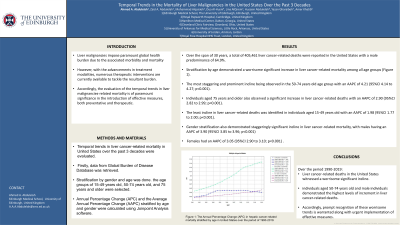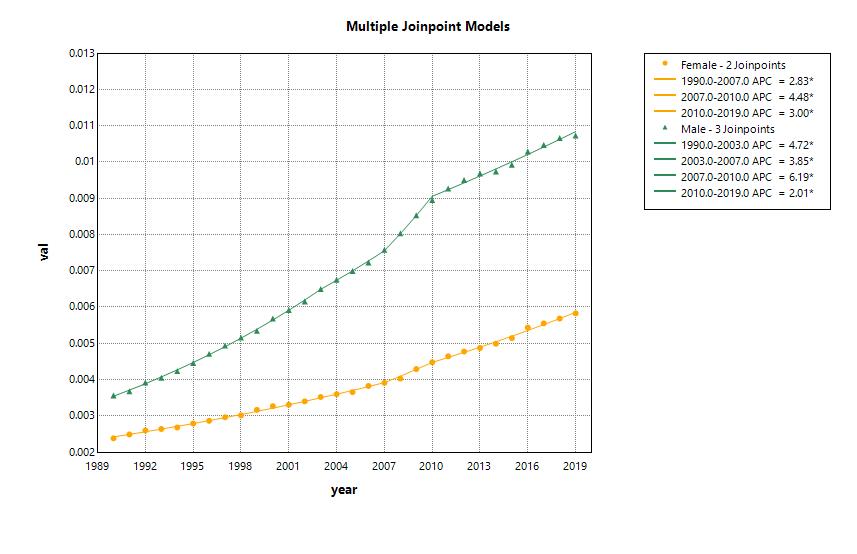Monday Poster Session
Category: Liver
P2902 - Temporal Trends in the Mortality of Liver Malignancies in the United States Over the Past 3 Decades
Monday, October 28, 2024
10:30 AM - 4:00 PM ET
Location: Exhibit Hall E

Has Audio

Ahmed A. A. Abdulelah, MD
University of Edinburgh
Edinburgh, Scotland, United Kingdom
Presenting Author(s)
Ahmed A. Abdulelah, MD1, Zaid A. Abdulelah, MD2, Mohammad Alqaisieh, MD3, Dua' Al-Husni, MD4, Lina AlQirem, MD5, Hussein Abdulelah, MD6, Yazan Gharaibeh, MD7, Amer Khatib, MD6
1University of Edinburgh, Edinburgh, Scotland, United Kingdom; 2Royal Papworth Hospital, Cambridge, England, United Kingdom; 3Hamilton Medical Center, Dalton, GA; 4Cleveland Clinic Foundation, Cleveland, OH; 5University of Arkansas for Medical Sciences, Little Rock, AR; 6University of Jordan, Amman, 'Amman, Jordan; 7Royal Free London NHS Trust, London, England, United Kingdom
Introduction: Liver malignancies impose paramount global health burden due to the associated morbidity and mortality. However, with the advancements in treatment modalities, numerous therapeutic interventions are currently available to tackle the resultant burden. Accordingly, the evaluation of the temporal trends in liver malignancies-related mortality is of paramount significance in the introduction of effective measures, both preventative and therapeutic.
Methods: The incidence of liver malignancies and the temporal trends in the United States over the past 30 years was initially evaluated by retrieval of data from the Global Burden of Diseases 2019 database. Joinpoint Analysis software was utilized to calculate the Annual Percentage Change (APC) and the Average Annual Percentage Change (AAPC), stratified by age and gender.
Results: Over the span of 30 years, a total of 405,461 liver cancer-related deaths were reported in the United States with a male predominance of 64.9%. Stratification by age demonstrated a worrisome significant increase in liver cancer-related mortality among all age groups with the most staggering and prominent incline being observed in the 50-74 years old age group with an AAPC of 4.21 (95%CI 4.14 to 4.27; p< 0.001). Individuals aged 75 years and older also observed a significant increase in liver cancer-related deaths with an AAPC of 2.90 (95%CI 2.82 to 2.99; p< 0.001). The least incline in liver cancer-related deaths was identified in individuals aged 15-49 years old with an AAPC of 1.98 (95%CI 1.77 to 2.00; p< 0.001). Gender stratification also demonstrated staggeringly significant incline in liver cancer-related mortality, with males having an AAPC of 3.90 (95%CI 3.85 to 3.96; p< 0.001) while females had an AAPC of 3.05 (95%CI 2.90 to 3.10; p< 0.001) (Figure 1).
Discussion: Liver cancer-related deaths in the United States witnessed a worrisome significant incline over the period of 1990-2019. Notably, individuals aged 50-74 years old and male individuals demonstrated the highest levels of increment in liver cancer-related deaths. Accordingly, prompt recognition of these worrisome trends is warranted along with urgent implementation of effective measures.

Disclosures:
Ahmed A. Abdulelah, MD1, Zaid A. Abdulelah, MD2, Mohammad Alqaisieh, MD3, Dua' Al-Husni, MD4, Lina AlQirem, MD5, Hussein Abdulelah, MD6, Yazan Gharaibeh, MD7, Amer Khatib, MD6. P2902 - Temporal Trends in the Mortality of Liver Malignancies in the United States Over the Past 3 Decades, ACG 2024 Annual Scientific Meeting Abstracts. Philadelphia, PA: American College of Gastroenterology.
1University of Edinburgh, Edinburgh, Scotland, United Kingdom; 2Royal Papworth Hospital, Cambridge, England, United Kingdom; 3Hamilton Medical Center, Dalton, GA; 4Cleveland Clinic Foundation, Cleveland, OH; 5University of Arkansas for Medical Sciences, Little Rock, AR; 6University of Jordan, Amman, 'Amman, Jordan; 7Royal Free London NHS Trust, London, England, United Kingdom
Introduction: Liver malignancies impose paramount global health burden due to the associated morbidity and mortality. However, with the advancements in treatment modalities, numerous therapeutic interventions are currently available to tackle the resultant burden. Accordingly, the evaluation of the temporal trends in liver malignancies-related mortality is of paramount significance in the introduction of effective measures, both preventative and therapeutic.
Methods: The incidence of liver malignancies and the temporal trends in the United States over the past 30 years was initially evaluated by retrieval of data from the Global Burden of Diseases 2019 database. Joinpoint Analysis software was utilized to calculate the Annual Percentage Change (APC) and the Average Annual Percentage Change (AAPC), stratified by age and gender.
Results: Over the span of 30 years, a total of 405,461 liver cancer-related deaths were reported in the United States with a male predominance of 64.9%. Stratification by age demonstrated a worrisome significant increase in liver cancer-related mortality among all age groups with the most staggering and prominent incline being observed in the 50-74 years old age group with an AAPC of 4.21 (95%CI 4.14 to 4.27; p< 0.001). Individuals aged 75 years and older also observed a significant increase in liver cancer-related deaths with an AAPC of 2.90 (95%CI 2.82 to 2.99; p< 0.001). The least incline in liver cancer-related deaths was identified in individuals aged 15-49 years old with an AAPC of 1.98 (95%CI 1.77 to 2.00; p< 0.001). Gender stratification also demonstrated staggeringly significant incline in liver cancer-related mortality, with males having an AAPC of 3.90 (95%CI 3.85 to 3.96; p< 0.001) while females had an AAPC of 3.05 (95%CI 2.90 to 3.10; p< 0.001) (Figure 1).
Discussion: Liver cancer-related deaths in the United States witnessed a worrisome significant incline over the period of 1990-2019. Notably, individuals aged 50-74 years old and male individuals demonstrated the highest levels of increment in liver cancer-related deaths. Accordingly, prompt recognition of these worrisome trends is warranted along with urgent implementation of effective measures.

Figure: Figure 1: The Annual Percentage Change (APC) in liver cancer-related deaths stratified by gender in the United States during the period 1990-2019.
Disclosures:
Ahmed Abdulelah indicated no relevant financial relationships.
Zaid Abdulelah indicated no relevant financial relationships.
Mohammad Alqaisieh indicated no relevant financial relationships.
Dua' Al-Husni indicated no relevant financial relationships.
Lina AlQirem indicated no relevant financial relationships.
Hussein Abdulelah indicated no relevant financial relationships.
Yazan Gharaibeh indicated no relevant financial relationships.
Amer Khatib indicated no relevant financial relationships.
Ahmed A. Abdulelah, MD1, Zaid A. Abdulelah, MD2, Mohammad Alqaisieh, MD3, Dua' Al-Husni, MD4, Lina AlQirem, MD5, Hussein Abdulelah, MD6, Yazan Gharaibeh, MD7, Amer Khatib, MD6. P2902 - Temporal Trends in the Mortality of Liver Malignancies in the United States Over the Past 3 Decades, ACG 2024 Annual Scientific Meeting Abstracts. Philadelphia, PA: American College of Gastroenterology.
